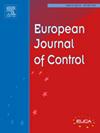考虑反馈环前后动态的非线性控制系统设计
IF 2.5
3区 计算机科学
Q2 AUTOMATION & CONTROL SYSTEMS
引用次数: 0
摘要
在实际应用中,控制下的动态物理系统通常伴随着不同类型的关联前动力学和后动力学,例如关于驱动和测量单元。然而,工业部门和研究实践中为这些系统设计的控制算法通常都集中在主设备上,而忽略了这些动态加载的关联模块的影响,这些关联模块可能在控制过程中临时添加,其动态可以通过使系统非线性复杂化而影响闭环系统行为,同时挑战其渐近稳定性。由于关联动力学在系统整体性能中起着至关重要的作用,因此本文重点研究了在控制器设计阶段引入关联动力学的问题。在测量不确定性和输入硬约束条件下,提出了一种集成传感器和执行器动力学的轨迹跟踪控制设计方法。为此,研究了在控制算法设计中考虑和不考虑传感器动态两种不同的方法。提出了基于梯度下降(GD)的最优双模离散滑模跟踪控制,并设计了参考轨迹重新设计的搜索算法。然后,从跟踪误差、控制能量和对参数不确定性的鲁棒性等方面对结果进行了研究。基于传感器组合的方法以较小的误差和较低的控制能耗实现了重新设计的轨迹跟踪。尽管测量动态忽略方法更加灵活,但由于其位置误差和控制能量曲线包围了基于传感器组合的方法,因此跟踪性能较差。基于传感器组合的方法也证明了对参数不确定性的鲁棒性,因为它在某些情况下成功地执行了将传感器动态忽略方法导向不稳定的方法。此外,为了证明所提出的控制器的性能,比较了两种不同的控制策略-有和没有设计基于优化的搜索算法-。搜索算法的加入大大降低了控制系统对实现参数预整定的依赖。与第二种策略相比,进一步减小了跟踪误差和控制能量。最后,除了控制器的有效性之外,上述方法和策略之间的对比仿真结果表明,在考虑输入硬约束的情况下,在控制设计阶段引入传感器动力学对跟踪误差、鲁棒稳定性和能量效率的影响。本文章由计算机程序翻译,如有差异,请以英文原文为准。
Designing nonlinear control system considering pre- and post-dynamics of feedback loop
In practical applications, dynamic physical systems under control can usually be accompanied by different types of associate pre- and post-dynamics, e.g. regarding actuation and measurement units. However, the designed control algorithms for these systems in both the industrial sector and research practices are typically focused on the main plant, neglecting the impacts of these dynamic-laden associate modules, which may have been added provisionally during the control procedure and whose dynamics can affect the closed-loop system behavior by complicating the system nonlinearities while challenging its asymptotic stability. Owing to this crucial role in the system overall performance, the controller design-stage incorporation of associate dynamics has been put into spotlight by this paper. It presents a trajectory tracking control design procedure, integrating sensor and actuator dynamics under measurement uncertainty and input hard constraints. To this end, two different approaches, namely with and without considering sensor dynamics in the control algorithm design, were explored. The Gradient Descent (GD)-based optimal two-mode discrete-time sliding mode tracking control with the searching algorithm devised for reference trajectory redesign was proposed. Then, the results were investigated in terms of tracking error, control energy, and robustness against parametric uncertainty. The sensor combined-based approach accomplishes redesigned trajectory tracking with less error and lower control energy consumption. Despite being more agile, the measurement dynamic-neglected approach posts poor tracking performance, as its position error and control energy curves enfold those of the sensor combined-based approach. The sensor combined-based approach also proves more robust against parametric uncertainty, as it successfully performs under some circumstances that direct the sensor dynamic-neglected approach toward instability. Additionally to demonstrate the performance of the proposed controller, two different control strategies – with and without devising the optimization-based searching algorithm – were compared. Adding the searching algorithm deeply decreases the control system dependence on the pre-tuning of implementation parameters. It also further reduces the tracking error and control energy compared to the second strategy. Finally, in addition to the effectiveness of the controller, results obtained from the comparative simulations conducted between the aforementioned approaches and strategies, show the impact of control design-stage incorporation of sensor dynamics in terms of tracking error, robust stability, and energy efficiency while considering input hard constraints.
求助全文
通过发布文献求助,成功后即可免费获取论文全文。
去求助
来源期刊

European Journal of Control
工程技术-自动化与控制系统
CiteScore
5.80
自引率
5.90%
发文量
131
审稿时长
1 months
期刊介绍:
The European Control Association (EUCA) has among its objectives to promote the development of the discipline. Apart from the European Control Conferences, the European Journal of Control is the Association''s main channel for the dissemination of important contributions in the field.
The aim of the Journal is to publish high quality papers on the theory and practice of control and systems engineering.
The scope of the Journal will be wide and cover all aspects of the discipline including methodologies, techniques and applications.
Research in control and systems engineering is necessary to develop new concepts and tools which enhance our understanding and improve our ability to design and implement high performance control systems. Submitted papers should stress the practical motivations and relevance of their results.
The design and implementation of a successful control system requires the use of a range of techniques:
Modelling
Robustness Analysis
Identification
Optimization
Control Law Design
Numerical analysis
Fault Detection, and so on.
 求助内容:
求助内容: 应助结果提醒方式:
应助结果提醒方式:


